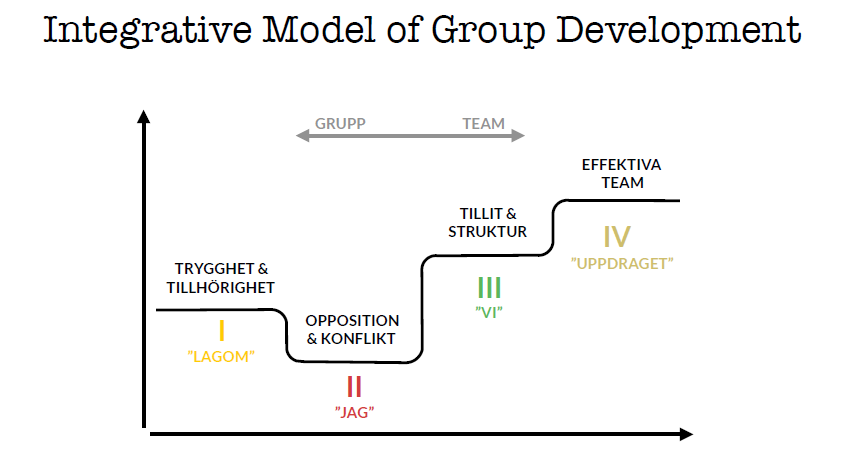Du vet säkert hur det är – i en ny grupp är många lite försiktiga i början. Efter ett tag börjar alla vara sig själva och då kan det uppstå gnissel. Och det är bra, för det visar att ni kommit till nivå två. Ta hjälp av IMGD-metoden så kan gå till nivå tre och fyra, och bli ert bästa team.
Vi vill ju alla vara vårt bästa jag. Varför inte också bli ert bästa team? Visste du att med rätt hjälp kan ett team kan öka sin prestation med en fjärdedel? På köpet kommer den glada känslan av att älska måndagar.
Vad är grupputveckling?
Grupputveckling är att medvetet förmå en grupp att utvecklas i en viss riktning. Alla grupper har sin egen dynamik som kan fångas och hanteras professionellt. Att göra processen tydlig för alla innebär att det skapas en stabil grund för samarbete.
Grupputveckling med IMGD-metoden
En av de mest etablerade metoderna för att bygga ett bra (bästa!) team kallas integrated model of group development, IMGD. Om ni testar Teamr så kommer ni att få lära er mer om det.
Psykologiprofessorn bakom IMGD heter Susan A Wheelan, hon samlade ihop tidigare gjord forskning och studerade tusentals grupper. Hennes modell blev den första vetenskapligt och statistiskt belagda teorin om grupper och hur grupper utvecklas.
Samma i alla grupper
Grupputveckling funkar likadant oavsett bransch, kultur, ålder eller andra faktorer. Det finns fyra faser som det gäller att ta sig igenom. Jobbigast är steg två med konkurrens och konflikter. Lättast är steg tre och fyra. I steg fyra är alla på topp! En del grupper lämnar aldrig steg ett.
Men hur gör man för att klättra uppåt? Det kan vara enklare än ni tror. Med Teamr får ni ett fantastiskt lättanvänt och smart verktyg för att nå nästa nivå.
Självskattning – var är er grupp just nu?
Med ett självskattningstest kan ni se på vilket steg ni befinner er just nu. Här är de olika stegen:
Steg 1
Formeringsfasen. Här är det viktigt att känna trygghet och tillhörighet. Gruppen är beroende av ledaren och det är viktigt vara en del av gruppen. Trygghet är viktigt och relationer byggs försiktigt. Man frågar sig: ”Varför är jag här? Vad förväntas av mig?”. Alla är artiga och talar om ofarliga saker. Teamet vill ha tydliga uppgifter och frågar om lov.
Steg 2
Konfliktfasen. Här blir det opposition och konkurrens. Det här är det mest kritiska steget där individuella behov tydliggörs. Man kan vara oenig om mål och gruppen utmanar ledaren och varandra, försöker övertyga varandra om vad som är ”rätt” och diskuterar oväsentligheter. Mycket handlar om frigörelse.
Steg 3
Normeringsfasen.Med ökad tolerans, närhet och öppenhet samlar sig teamet. Här byggs tillit och struktur. Konflikter hanteras när de uppstår och alla söker aktivt enighet och samsyn. Roller och uppdrag anpassas för att nå målen och det skapas strukturer som ökar produktiviteten.
Steg 4
Prestationsfasen. Här är teamet högpresterande och känner sig fantastiskt! Samarbetet är effektivt och intensivt, rollerna är klargjorda och kommunikationen är öppen. Energin går till måluppfyllelse och alla tar maximalt ansvar.
Det finns också ett sista steg.
Steg 5
Gruppen upplöses. Uppdraget är slutfört eller gruppen omorganiseras. Beroende på var gruppen befann sig innan så behöver det här steget hanteras på olika sätt. En del grupper känner sorg och ofta är det viktigt att ta med sig erfarenheter till nästa grupp. Medvetna och omedvetna känslor behöver utrymme.
Satsa på nivå tre och fyra
Faktum är att bara 20 procent av alla grupper når steg fyra. Men låt inte det hindra er – ingen vet hur långt just ni når med rätt hjälp. Varje fas har sina specifika frågeställningar att hantera för att komma vidare och varje fas kännetecknas av olika beteenden och behov. Det är förväntat.
Tänk på:
- Det här är en personlig resa, likaväl som en gruppresa.
- Var noga med att ge varandra konstruktiv feedback och håll regelbundna avstämningar.
- Lägg tid på att komma fram till en gemensam målbild.
- Allt kommer att vara oklart inledningsvis.
- Se konflikter som en möjlighet.
- Det tar flera månader att bli ett högpresterande team.
Telia ”supernöjda” med teambuilding online







